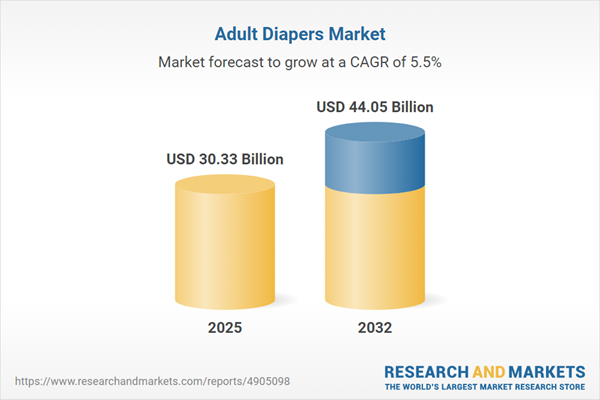Speak directly to the analyst to clarify any post sales queries you may have.
The global adult diapers market is evolving as demographic shifts, user needs, and emerging technologies alter the landscape for care providers and manufacturers. Senior executives require robust market analysis to guide effective planning in this essential healthcare segment.
Market Snapshot: Adult Diapers Market 2024–2032
Between 2024 and 2032, the adult diapers market is projected to experience strong expansion, underpinned by rising demand related to age-associated incontinence and heightened healthcare awareness. The market is benefiting from the introduction of advanced absorbent materials and more efficient production techniques. These developments have enabled the creation of discreet, comfortable, and adaptable adult diaper products to meet evolving user expectations. Growth is further fueled by widespread acceptance in both home-based and clinical care environments. Organizations are investing strategically in product differentiation, process agility, and compliance with regulatory changes. Such efforts help firms better address the complex and diverse needs of global populations and maintain competitiveness in a dynamic environment.
Scope & Segmentation: Adult Diapers Market
- Product Types: Belted, pull-on, and tape-fastened adult diapers address varied mobility and care requirements, supporting both independent living scenarios and institutional care settings.
- Age Groups: Product solutions are calibrated for adults aged 18–40 who prioritize convenience and movement, those aged 41–64 with needs centered around privacy and comfort, as well as seniors who require extended support during rehabilitation or ongoing medical care.
- Absorbency Levels: Offerings span from lightweight options for routine, daily home usage to ultra-absorbent designs suited for hospital environments and long-term care applications.
- End Users: Adult diapers serve individual users, healthcare facilities, clinics, and long-term care centers, each benefiting from ergonomic, easy-to-manage packaging that encourages compliance and efficient handling.
- Distribution Channels: Procurement routes include hospitals, pharmacies, supermarkets, hypermarkets, and online retail platforms, ensuring broad accessibility for both medical professionals and consumers in urban and rural locales.
- Geographic Coverage: The market encompasses key regions such as the United States, Germany, Japan, China, Brazil, and Canada. Each geography features distinct regulatory frameworks, purchasing habits, and user profiles. North America, Europe, and Asia-Pacific exhibit particularly varied adoption and operational contexts.
- Technological Innovation: Advanced features like smart sensors and telehealth integration, as well as eco-friendly materials, enhance patient monitoring, strengthen data-driven care, and contribute to sustainability initiatives in the sector.
- Leading Industry Players: The competitive landscape is influenced by prominent companies, including Kimberly-Clark Corporation, Procter & Gamble, Essity AB, Unicharm Corporation, Domtar Corporation, Ontex Group NV, Paul Hartmann AG, Medline Industries, Kao Corporation, and Cardinal Health, Inc., who shape development priorities and establish performance benchmarks.
Key Takeaways for Decision-Makers
- Expanding and diversifying adult diaper product lines facilitates rapid adaptation to care delivery reforms and evolving end-user requirements.
- Deployment of digital health technologies and integrated smart sensing supports efficient patient monitoring, aiding institutional caregivers in workflow optimization.
- Adoption of sustainable sourcing and environmentally responsible materials supports environmental, social, and governance goals, meeting the expectations of institutional and private buyers across regions.
- Flexible sales and procurement strategies—balancing digital and traditional channels—extend product reach to medical providers, institutions, and household buyers in various markets.
- Reinforced supply chain practices allow organizations to minimize disruptions, adjust for cost fluctuations, and align with evolving regulatory demands without delaying product availability.
- Cross-functional collaboration between research, product development, and procurement teams accelerates market adaptation and strengthens linkages throughout the supply and distribution ecosystem.
Tariff Impact: Raw Material and Supply Chain Challenges
Recent imposition of U.S. tariffs on superabsorbent polymers and nonwoven fabrics has led to higher production costs and added complexities for industry supply chains. Leading manufacturers are responding by expanding supplier networks, boosting operational stability, and refining manufacturing processes to protect distribution reliability in the face of trade policy adjustments and global market volatility.
Methodology & Data Sources
This analysis draws on direct interviews with procurement leaders, healthcare practitioners, and institutional buyers. Additional validation comes from demographic analysis, comprehensive market segmentation studies, SWOT reviews, regulatory assessments, and independent benchmarking. Together, these methods ensure the market outlook supports timely and actionable planning for adult diapers.
Why This Report Matters
- Enables leadership teams to align procurement, product development, and investment decisions directly with changing adult diaper market dynamics.
- Clarifies the influence of technological innovation, compliance trends, and industry competition on risk management and continuity planning.
- Supports forward-looking resource allocation and assists organizations in sustaining regulatory compliance as both user needs and operational demands change.
Conclusion
Timely, comprehensive intelligence is essential for effective market navigation. This report equips decision-makers with the tools and insights to confidently address new opportunities and evolving challenges in the adult diapers sector.
Additional Product Information:
- Purchase of this report includes 1 year online access with quarterly updates.
- This report can be updated on request. Please contact our Customer Experience team using the Ask a Question widget on our website.
Table of Contents
3. Executive Summary
4. Market Overview
7. Cumulative Impact of Artificial Intelligence 2025
Companies Mentioned
The companies profiled in this Adult Diapers market report include:- Kimberly-Clark Corporation
- The Procter & Gamble Company
- Essity AB (publ)
- Unicharm Corporation
- Domtar Corporation
- Ontex Group NV
- Paul Hartmann AG
- Medline Industries, L.P.
- Kao Corporation
- Cardinal Health, Inc.
Table Information
| Report Attribute | Details |
|---|---|
| No. of Pages | 181 |
| Published | October 2025 |
| Forecast Period | 2025 - 2032 |
| Estimated Market Value ( USD | $ 30.33 Billion |
| Forecasted Market Value ( USD | $ 44.05 Billion |
| Compound Annual Growth Rate | 5.4% |
| Regions Covered | Global |
| No. of Companies Mentioned | 11 |









